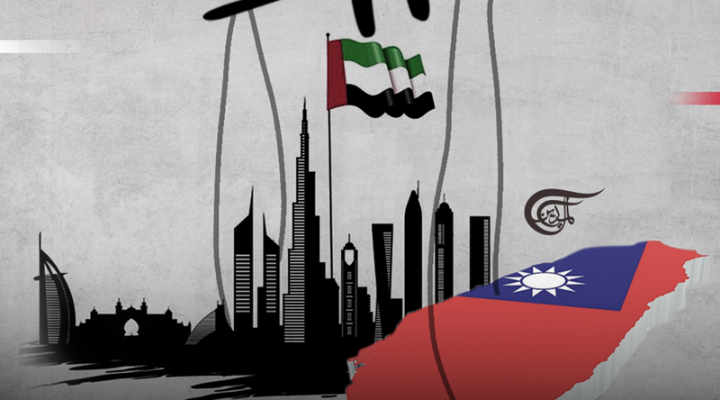UAE replicates ‘Taiwan’

A US ‘sentinel’ state on the Bab-el-Mandab choke-point, disrupting China’s Maritime Silk Road.
The US is at least, now, clear-eyed about its overarching strategy: It is to barricade both China and Russia within the borders of their own territories, and to contain them through the ‘standing-up’ of unbroken chains of ‘sentinel states’ in order to contain both countries on every front, and potentially cripple their economy in any future crisis.
In addition – harking back to the Reagan era – Ukraine and Taiwan are nominated to be the analogs to the myth that Afghanistan was the back-breaking quagmire in which the US mired the Soviet Union. It is a myth — I was there at the time. The USSR folded under the weight of its inherent contradictions. It was not defeated in Afghanistan.
But never mind; the myth has become dogma and is now re-born with Ukraine and Taiwan being set up as both continuous pressure points, and as the info-war poles around which the US can mobilize and turn global opinion decisively against China and Russia.
The text of the US’ 2022 National Defense Authorisation Act is quite clear about this. It provides an overarching plan for curbing China’s rise, thereby aiming to ensure America’s permanent supremacy. With Taiwan being converted into a de facto military ally of the United States, there could hardly be a more direct assault on China’s bottom line: that, sooner or later, the island must agree to peacefully reunite with the mainland, or face military action.
The point here is that ‘encirclement’ and ‘containment’ effectively have become the Biden Administration’s Meta objective – and cemented – in the first step to this meta-doctrine currently is being enacted out via Russia (as the initial Biden era step along the path defined in the 2022 NDAA). The containment notion, of course, reaches back to the post-WW2 period, yet it unfolds today in unexpected ways — ways that reflect the onset of a new ‘war’.
Not so much a new iteration of the Cold War, but the beginning of the Russia-China-Iran Axis’ ‘war’ to blow apart their ‘containment and encirclement’. It was effectively launched by Russia with its publication of a draft Treaty demanding that NATO pack-its-bags, and get out from its encroachment into the Asian heartland. These two documents published by Moscow represent a considered, coordinated strategic challenge to the US imposed global order.
Paradoxically however, amongst the first visible signs to this newly launched ‘war-to blow-apart-encirclement’ is one that took place in the unlikely setting of the UAE, with the 17 January missile and drone attack on Abu Dhabi — an attack claimed by Ansar Allah. This event, inter alia, is directly connected with those three targeted states’ bigger ‘war’ to break US encirclement.
In terms of the maritime – and energy supply line – containment of the China-Russia Axis, there are three main global choke-points that could serve to cripple and disrupt the Eurasian economy, if controlled and blocked by the US and its allies. They are the Strait of Malacca, which is but 1.5 nautical miles wide at its narrowest point; Hormuz (also very narrow); and the Bab-el-Mandab strait, which lies between Yemen and the Horn of Africa.
Plainly, one key vulnerability to Eurasian economic prosperity in upcoming years will lie with China’s Maritime Silk Road — a shipping route which inevitably pivots around the Horn of Africa, and its choke-point of the Bab-el-Mandab Strait, off Yemen’s coast.
The geography of southern Yemen therefore offers the US a key hub by which it might ‘contain’ and deny China its’ Maritime Silk Road, in times of crisis.
In this context, the UAE plays the Mid-East strategic counterpart to ‘Taiwan’ which is the US security ‘anchor’ in the Pacific to a chain of ‘sentinel’ strong-points — the UAE becoming rather, the geographical anchor to the ‘sentinel’ ports and islands overlooking the Indian Ocean, the Arabian Sea, the Red Sea, the Horn of Africa, and the Bab-el-Mandab strait (all presently controlled by the UAE.)
The enhanced strategic significance of the UAE to “Israel” and the US, therefore almost wholly derives from its having blatantly used the Yemen war as an opportunity to establish an oversized role for itself, through seizing the ‘guardianship’ of the strait connecting the Red Sea to the Gulf of Aden.
Thus, the port of Aden, the Bab-el-Mandab Strait and Socotra Island fall neatly into a vital component of the Cold War build-up between China and the US. The Arab ally that can control this essential strait will give the US leverage with which to jeopardize China’s Maritime Silk Road – and hence is seen in some Washington circles as justifying America’s support for the ongoing conflict in Yemen.
We note that the US and Israeli fear of the Ansar Allah taking Marib City and the province was sufficient gravity to prompt an American decision to force the UAE to reconsider its Yemen war “exit strategy” — and to re-engage precisely to prevent the fall of Marib, with the prospect of further strategic dominos falling to the Ansar Allah, all the way to Bab-el-Mandab.
Hence the Houthi drone attack on UAE, signaling that they have no intention of conceding such vital maritime choke-points.
Ansar Allah are giving the UAE a bitter choice: Strikes on its cities, or yield up the strategic asset of Bab-el-Mandab and its surroundings. Iran and China will be watching closely the outcome of this ‘encirclement-breakout’ initiative.
Anyone wondering why the war in Yemen doesn’t end has their answer: The Yemen war has become a strategic component to crippling America’s encirclement strategy.
https://english.almayadeen.net/articles/analysis/uae-replicates-taiwan
 TheAltWorld
TheAltWorld 
0 thoughts on “UAE replicates ‘Taiwan’”